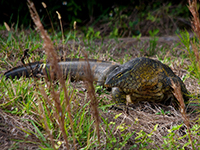Is Containment or Eradication Possible for Invasive Nile Monitors?
Currently, the four largest species of lizards established in Florida are nonnative species. One of these large lizards, the Nile monitor (Varanus niloticus), can grow to more than six feet in length and is native to sub-Saharan Africa. Nile monitors are known to have breeding populations in Lee and Palm Beach Counties, but evidence suggests that established populations may also exist in Miami-Dade and Broward Counties. Nile monitors are strong swimmers, climbers, and generalist predators. They are known to prey upon aquatic and terrestrial invertebrates and vertebrates, and the eggs of reptiles and birds. This makes them a threat to native wildlife, including endangered and threatened species like American crocodiles, sea turtles, and burrowing owls.
The University of Florida research team collaborates with the Florida Fish and Wildlife Conservation Commission, South Florida Water Management District, U.S. Fish and Wildlife Service, and other members of the Everglades Cooperative Invasive Species Management Area in order to better understand distribution, relative abundance, and future management of Nile monitors in Palm Beach County by:
- Conducting weekly surveys of canals in the C-51 basin
- Placing remote cameras and traps as methods of detection and control
- Evaluating the most effective control efforts in order to determine whether containment or eradication is possible
- Improving public awareness through outreach and education efforts
There have been other species of monitor lizards found in South Florida, including the common water monitor (Varanus salvator) and savannah monitor (Varanus exanthematicus), but with no evidence of breeding.
Images
Links
FWC Nonnatives - Nile monitor info
Everglades CISMA - Nile Monitor info
EDDMapS - Nile Monitor distribution
Publications
Mazzotti, F.J., Nestler, J.H., Cole, J.M., Closius, C., Kern, W.H., Rochford, M.R., Suarez, E., Brubaker, R., Platt, S.G., Rainwater, T., & Ketterlin, J.K. 2020. Diet of Nile Monitors (Varanus niloticus) Removed from Palm Beach and Broward Counties, Florida, USA. Journal of Herpetology. 54(2): 189-195. Full PDF
Ketterlin Eckles, J.K., Mazzotti, F.J., Giardina, D., Hazelton, D., & Rodgers, H.L. (2017). First Evidence for Reproduction of Nile Monitors (Varanus niloticus) in Palm Beach County. Southeastern Naturalist 15(sp8): 114-119. Full PDF






